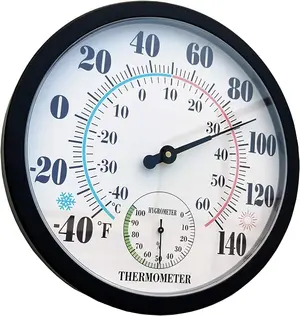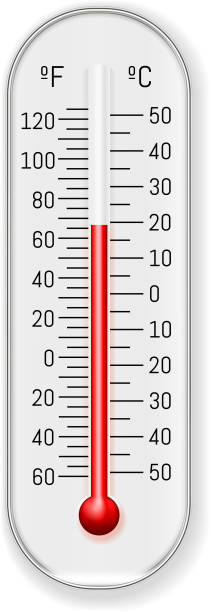Exploring the Wonders of Outdoor Thermometers: A Guide to Understanding, Choosing, and Utilizing
Outdoor thermometers are essential devices designed to measure and display outdoor temperatures. They come in various types, including analog, digital, and infrared models. These instruments serve multiple purposes, providing valuable information for personal use in gardening, outdoor activities, and ensuring safety during temperature extremes. Moreover, they play a crucial role in scientific research, aiding meteorologists and environmentalists in climate observation and understanding weather patterns. Accurate placement, regular maintenance, and a clear understanding of the readings are key to effectively utilizing outdoor thermometers. Whether for personal or scientific use, these devices are indispensable tools for tracking and interpreting outdoor temperature variations.
Significance of Outdoor Thermometers.

In the realm of weather tracking and understanding climate variations, outdoor thermometers play a pivotal role. From the traditional mercury-based devices to the modern digital versions, these instruments provide essential data for assessing weather conditions, aiding in gardening, ensuring safety in extreme temperatures, and contributing to various scientific fields. In this comprehensive guide, we delve into the depths of outdoor thermometers, exploring their types, working mechanisms, significance, and usage. Understanding these tools is crucial not only for personal utility but also for scientific and environmental observations.
Understanding Outdoor Thermometers
Types of Outdoor Thermometers
Outdoor thermometers come in diverse types, each tailored for specific purposes:
- Analog Thermometers: These are traditional thermometers, often seen with a glass tube containing mercury or alcohol. They display the temperature through a scale and a liquid-filled bulb, reacting to the surrounding temperature changes.
- Digital Thermometers: More modern, these use electronic sensors to measure temperature, displaying the reading numerically on an LCD screen. Some models might have additional features such as recording maximum and minimum temperatures, wireless capabilities, and weather forecast displays.
- Infrared Thermometers: Also known as IR thermometers, these non-contact devices measure temperature from a distance using infrared technology. They are particularly useful for measuring surfaces or areas where traditional thermometers can't reach.
Working Mechanism
An outdoor thermometer's core function revolves around the physical principle of temperature expansion and contraction. In analog thermometers, the liquid within the bulb expands or contracts based on the surrounding temperature, causing it to rise or fall in the tube. Digital thermometers use electronic sensors to detect temperature changes and convert them into numerical values for display.

Significance of Outdoor Thermometers
1. Personal Use: For homeowners, gardeners, and outdoor enthusiasts, outdoor thermometers provide vital information for planning outdoor activities, determining suitable plant species, and understanding weather patterns. They serve as an early warning system for extreme temperatures, aiding in safeguarding against frost damage or heat-related issues.
2. Scientific and Environmental Contributions: In scientific research, outdoor thermometers play a crucial role in climate observation, aiding meteorologists and environmentalists in studying climate change, weather patterns, and temperature trends. The data collected from various outdoor thermometers worldwide helps in global climate assessments and understanding long-term environmental changes.
Using Outdoor Thermometers Effectively
1. Placement: Proper placement is essential for accurate readings. An outdoor thermometer should be positioned away from direct sunlight, heat sources, or areas prone to drafts. Mounting it at eye level ensures easy reading and protects it from environmental interferences.
2. Maintenance: Regular calibration and maintenance are crucial for accurate readings. Clean the thermometer regularly to remove dirt or debris that might affect its accuracy. Battery replacement or calibration checks for digital thermometers are vital to ensure precise readings.
3. Understanding Readings: Different thermometers have various scales, like Celsius or Fahrenheit. Understanding the scale and its respective readings is vital for interpreting the temperature correctly. Additionally, some thermometers might offer humidity or barometric pressure readings, providing a comprehensive understanding of weather conditions.
Advantages of Outdoor Thermometers
- Temperature Monitoring: Outdoor thermometers allow for the constant monitoring of external temperatures, providing crucial data for planning outdoor activities, gardening, and ensuring safety during extreme weather conditions.
- Weather Forecasting: They assist in predicting immediate weather changes. Sudden drops or rises in temperature might signify impending weather shifts, aiding in preparation for storms, frosts, or heatwaves.
- Gardening Aid: These thermometers help gardeners choose suitable plants for their outdoor space, ensuring that plants are compatible with the prevailing climate.
- Scientific Contributions: Outdoor thermometers contribute to scientific research by providing long-term data for weather patterns and climate change studies.
- Varied Types: With analog, digital, and infrared options, users have a range of choices based on accuracy, convenience, and specific functionalities.

Disadvantages of Outdoor Thermometers
- Potential Inaccuracy: Analog thermometers, especially mercury-based ones, may be less accurate due to environmental factors, such as changes in altitude or barometric pressure. Digital thermometers, while generally more accurate, can still be affected by calibration issues or electronic malfunctions.
- Maintenance Needs: Regular maintenance, such as cleaning and calibration, is necessary to ensure accurate readings, especially for analog thermometers. Digital thermometers might require battery changes or recalibration.
- Environmental Limitations: Placement can significantly affect accuracy. Exposure to direct sunlight, drafts, or nearby heat sources can impact the readings. Moreover, some models might not be suitable for extremely cold or hot environments, affecting their functionality.
- Limited Features in Some Models: Basic outdoor thermometers might only display temperature readings, lacking additional features like humidity or weather forecasts available in more advanced models.
- Cost Variation: More accurate and feature-rich digital thermometers can be expensive compared to basic analog ones, making them less accessible for some users.
Functions of Outdoor Thermometer
The functions of an outdoor thermometer extend beyond merely measuring temperature. They serve various purposes that are crucial for personal, professional, and scientific applications. Some of the key functions include:
- Temperature Measurement: The primary function of an outdoor thermometer is to measure and display the temperature in the external environment. This measurement is essential for various activities and decision-making, such as determining appropriate clothing for outdoor conditions, preparing for weather changes, and understanding climate variations.
- Gardening Aid: Outdoor thermometers assist gardeners in selecting and cultivating plants suitable for the prevailing outdoor temperatures. They provide information critical for plant growth, helping gardeners make informed choices about the types of plants that thrive in specific climates.
- Weather Observation: These thermometers aid in observing and monitoring local weather conditions. Sudden changes in outdoor temperature readings can indicate potential weather shifts, helping individuals prepare for forthcoming weather events.
- Safety Precautions: They serve as a safety tool during extreme weather conditions. For instance, in cases of excessive heat or cold, these devices provide valuable information for taking appropriate safety measures to prevent health issues related to extreme temperatures.
- Scientific Research: Outdoor thermometers contribute to scientific data collection. The temperature readings obtained from these devices are used in various fields, including meteorology, environmental science, and climate studies. They assist in gathering long-term weather and climate data necessary for research and analysis.
- Indoor Climate Control: By comparing outdoor temperatures with indoor readings, individuals can make adjustments to indoor heating or cooling systems, enhancing comfort and energy efficiency.
- Predictive Insights: Monitoring outdoor temperatures can provide insights into seasonal variations and climate trends, aiding in long-term forecasting and planning.

Frequently Asked Questions (FAQ)
Which outdoor thermometer is most accurate?
Most accurate outdoor thermometer: In general, digital thermometers tend to be more accurate compared to analog ones. Digital thermometers use electronic sensors that are precise in measuring temperature variations. However, the accuracy can vary based on the specific model, quality, and calibration of the thermometer.
What is in an outdoor thermometer?
Components of an outdoor thermometer: An outdoor thermometer typically consists of a temperature sensor (either a bulb filled with a liquid such as mercury or alcohol in analog thermometers, or electronic sensors in digital ones), a scale or display to indicate temperature readings, and a casing or housing to protect the device from environmental factors.
Where is an outdoor thermometer used?
Where an outdoor thermometer is used: Outdoor thermometers are primarily used outside, in locations such as gardens, yards, balconies, or any outdoor setting. They're placed to monitor the temperature changes in the environment, providing crucial information for gardening, outdoor activities, and weather observation.
What is the outside temperature thing called?
The device used for measuring outside temperature: An outdoor thermometer is specifically designed to measure the temperature outside. This device is often simply referred to as an "outdoor thermometer" or a "weather thermometer," serving the purpose of monitoring and displaying the external temperature variations.
What are the Effects on Outdoor Thermometer?
Outdoor thermometers can be affected by various environmental factors and issues that may impact their accuracy and functionality. Some common effects on outdoor thermometers include:
- Exposure to Sunlight: Direct exposure to sunlight can cause temperature readings to be higher than the actual ambient temperature. This effect is more pronounced in analog thermometers with dark casings or those placed in direct sunlight.
- Radiation and Reflection: Radiation from nearby surfaces or reflected heat can influence the thermometer's reading. Placing the thermometer near surfaces that absorb or reflect heat, such as walls or concrete, can lead to inaccurate temperature measurements.
- Wind and Drafts: Strong winds or drafts can impact the thermometer's accuracy by altering the actual temperature around the sensor. Positioning the thermometer in areas prone to drafts can lead to fluctuating readings.
- Altitude and Barometric Pressure: Changes in altitude and barometric pressure can affect the boiling point of liquids inside analog thermometers, leading to inaccuracies in temperature readings.
- Humidity and Condensation: Moisture, humidity, or condensation can affect the visibility of the thermometer's scale or electronic display. Additionally, in extreme cold temperatures, moisture can freeze and impact the thermometer's accuracy.
- Poor Calibration or Maintenance: Lack of regular maintenance, calibration, or damage to the thermometer can result in inaccurate readings. This issue is more prevalent in analog thermometers due to their sensitivity and susceptibility to damage.
- Electronic Malfunctions: In digital thermometers, electronic malfunctions due to battery issues, wiring problems, or sensor damage can lead to incorrect readings or a complete failure of the device.
Outdoor thermometers, whether traditional analog or modern digital devices, are indispensable tools for both personal and scientific purposes. Their role in understanding weather patterns, aiding in gardening, ensuring safety in extreme temperatures, and contributing to climate research cannot be overstated. As technology advances, these devices continue to evolve, offering more accurate readings and additional features for a diverse range of users.
In a world where climate fluctuations have a significant impact on daily life and global environmental concerns, the role of outdoor thermometers becomes increasingly vital. By understanding their types, workings, significance, and utilizing them effectively, individuals can make informed decisions, contribute to research, and adapt to changing weather conditions more efficiently.



